Evaluation Of The Use And Formulation Of Cosmeceuticals Sample Assignment
ABSTRACT
Background
Antioxidants are compounds that counteract the harmful effects of reactive oxygen species in the cells of the body. Oxidative stress results when there is an imbalance between the level of pro-oxidants such as free radicals and reactive oxygen species and the level of antioxidants in the cell. The pro oxidants can cause damage to the cells, only when the cell is deprived of antioxidants. Antioxidants act by either stabilizing the free radical species or by deactivating them. Retinol or Vitamin A is fat-soluble antioxidant that serves to prevent photoageing. Retinols affect the processes of cell growth and differentiation, alterations in cell surface proteins and immune system modulation. L- Ascorbic acid is the biologically active form of Ascorbic acid and used for treatment processes. Not only does it act as an antioxidant to counteract the ROS, but it also has properties of collagen synthesis and can act as a depigmenting agent.
Objective
The objective of this study is to judge the efficacy of the two components, L-Ascorbic Acid and Retinol, when being used as topical antioxidant, in an age group of 18-50 years.
Methods
63 participants, belonging to the age-group of 18-30 years were surveyed after they had been using both the antioxidant crèmes on two different halves of the face, for a period of 6 weeks
Results
When the participants were surveyed regarding their perception on the use of L-Ascorbic Acid as a topical antioxidant agent, 52.38% of the participants agreed to the fact that the texture of the product and the consistency was comfortable while almost 43% were of the view that the texture was too light. The same perception, when tested for Retinol gave the results that almost 80% of the participants agreed for the product texture being comfortable and 14% agreed to it being too light. Almost 62% of the participants voted for the perception that the product caused slight improvement in the pigmentation conditions while 6% saw a significant improvement in their skin pigmentation levels. In case of Retinol, the percentages were 23.80% and 0%. This means that L-ascorbic Acid is better in curing skin pigmentation problems than Retinol.
Conclusion
After the survey, it could be effectively concluded that L-Ascorbic Acid acts as a better antioxidant agent than Retinol, especially when reducing pigmentation problems and improving the skin texture of the users.
Introduction
Antioxidants are compounds that counteract the harmful effects of reactive oxygen species in the cells of the body. All living organisms use oxygen in order to carry out respiration. Respiration is the oxidation of food materials such as carbohydrates, proteins and fats in order to liberate energy, which is stored in the form of ATP. However, oxygen being a highly reactive molecule is capable of forming free radicals that are highly damaging to the cells. Free radicals are a major cause of aging and diseases like cardiovascular diseases, cancer and loss of brain and immune functions. Free radicals contain unpaired electrons, and therefore it tends to react with other substances in order to capture electrons from them, which would make them stable entities. Reactive oxygen species, which forms several free radicals, interact with phospholipids in the cell membrane and proteins, nucleic acids and enzymes in the cell (Ray et al., 2012).
Oxidative stress results when there is an imbalance between the level of pro-oxidants such as free radicals and reactive oxygen species and the level of antioxidants in the cell. The pro oxidants can cause damage to the cells, only when the cell is deprived of antioxidants. Antioxidants act by either stabilizing the free radical species or by deactivating them. The main sources of antioxidants are fruits and vegetables (Gülçin, 2012). Ascorbic acid (Vitamin C) and retinol (Vitamin A) are the components that provide antioxidant properties to these food items.
Ascorbic acid is a major water-soluble antioxidant, which is highly recommended to reduce photo ageing (Traikovich, 2009). In addition to chronological aging, photo ageing is increasing in recent times. Photo ageing refers to the damage caused to the skin due to the harmful UV radiations of the sun. Ascorbic acid is a major component of several creams and serums that are applied topically on the skin surfaces in order to prevent photoageing. Ascorbic acid is found in two isomeric forms, namely L- ascorbic acid and D- ascorbic acid. L- Ascorbic acid is the biologically active form of Ascorbic acid and used for treatment processes. LAA is preferred for topical application as only a negligible amount of it can be absorbed by the small intestine (Telang, 2013). Additionally if Vitamin C is administered orally, its bioavailability to the skin is lowered. Not only does it act as an antioxidant to counteract the ROS, but it also has properties of collagen synthesis and can act as a depigmenting agent.
Retinol or Vitamin A is fat-soluble antioxidant that serves to prevent photoageing. Retinols affect the processes of cell growth and differentiation, alterations in cell surface proteins and immune system modulation (Mukherjee, 2018). The effects of retinols are manifested due to various interactions retinols have with the cellular and nucleic acid receptors (Babamiri and Nassab, 2012). Among retinol compounds that are used for topical treatment of photoageing, tretinoin is the most important. However, tretinoin has several side effects that include burning, scaling and dermatitis (Skinceuticals-za.com. 2018). Therefore, further research is required to establish tretinoin as a successful topical agent for treating photoageing.
Methods
The trial was aimed to be carried out among the individuals belonging to the age group of 18 yrs-50 yrs, non-random group in which all the female students and only one male student who were initially on-campus students of the university, participated in the survey. The duration of the trial was 6 weeks during which the participants were required to apply the different samples of the antioxidant creams manufactured by using L-Ascorbic acid and retinol, on two separate halves of the face. The retinol-based cream was required to be applied on the left-side of the face while l-Ascorbic acid was required to be applied on the right side. One important factor determined the success of the use of topical antioxidants on the face of the participants; the face required to be clean from any dirt or impurities before the application of the cream, in order to ensure that there was no side effects occurring from the impurities which stayed back in the pores of the face. In order to ensure minimal cross-reactivity, no other compounds were advised to be used along with the topical creams formulated; this also served to ensure that the results obtained on the skin, whether good or bad, could be attributed to the use of the sample antioxidant crèmes under experimentation. The participants were surveyed about their views and the results on their skin after a span of 6 weeks and those were evaluated by means of graphs constructed on the reviews obtained.
Results
The data collected from the 63 student participants, regarding the topical application of L-Ascorbic acid and Retinol as antioxidants on half of the face, for a period of six weeks revealed the fact that the users were differently tolerable to the levels of Ascorbic acid and Retinol. The action on the individuals also varied considerably. Both the products exhibited anti-ageing activities on the users and helped in the reduction of fine lines and pigmentation. Most of the individuals did not develop any rashes or irritation when the products were used on the skin, thus stating the fact that both L-Ascorbic Acid as well as Retinol were safe to be used as topical agents except on those individuals who were overtly sensitive to the products.
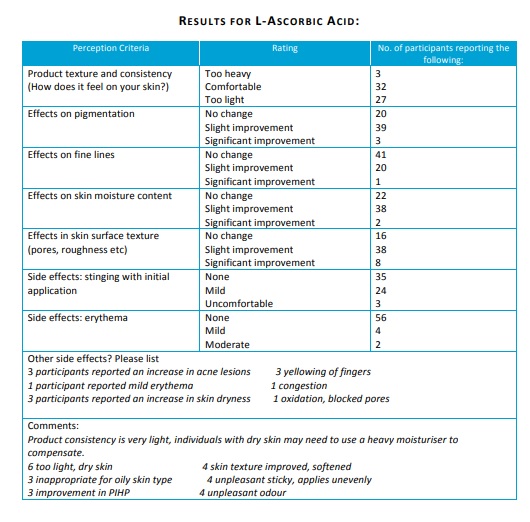
Fig: The collated results of the survey for L-Ascorbic Acid
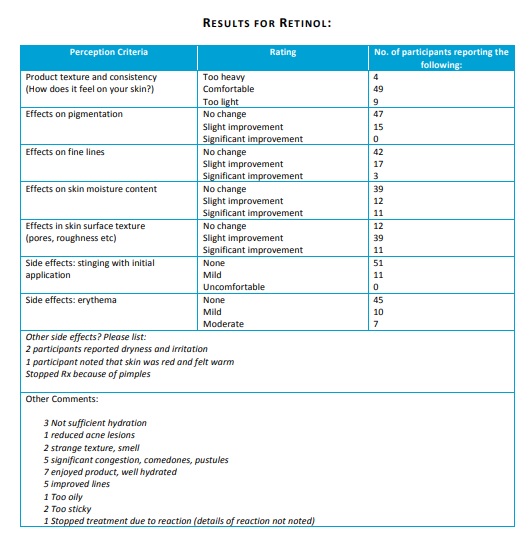
Fig: The collated results of the students regarding retinol
My results after application of L-Ascorbic Acid
|
Perception Criteria |
Rating |
|
Product Texture and consistency |
Comfortable |
|
Effects in Pigmentation |
Significant Improvement |
|
Effects on fine lines |
Slight Improvement |
|
Effects on skin moisture content |
No change |
|
Effects in skin surface texture |
Slight Improvement |
|
Side effects: stinging with initial application |
None |
|
Side effects: erythema |
None |
Collated results of the participants after the application of L-Ascorbic Acid
|
Perception Criteria |
Rating |
No. of Participants |
Percentage |
|
Product Texture and consistency |
Too heavy |
3 |
4.76 |
|
Comfortable |
33 |
52.38 | |
|
Too Light |
27 |
42.85 | |
|
Effects in Pigmentation |
No change |
20 |
31.74 |
|
Slight Improvement |
39 |
61.90 | |
|
Significant Improvement |
4 |
6.00 | |
|
Effects on fine lines |
No Change |
41 |
65.07 |
|
Slight Improvement |
21 |
33.33 | |
|
Significant Improvement |
1 |
1.58 | |
|
Effects on skin moisture content |
No Change |
22 |
66.66 |
|
Slight Improvement |
39 |
61.90 | |
|
Significant Improvement |
2 |
3.17 | |
|
Effects in skin surface texture |
No Change |
16 |
25.39 |
|
Slight Improvement |
39 |
61.90 | |
|
Significant Improvement |
8 |
12.69 | |
|
Side effects: stinging with initial application |
None |
36 |
57.14 |
|
Mild |
24 |
38.09 | |
|
Uncomfortable |
3 |
4.76 | |
|
Side effects: erythema |
None |
57 |
90.47 |
|
Mild |
4 |
6.34 | |
|
Moderate |
2 |
3.17 |
Graphs for the Collated results of the participants after the application of L-Ascorbic Acid
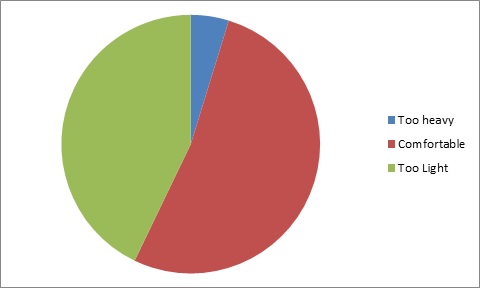
Fig 1: Product Texture and consistency
Source: Created by Author
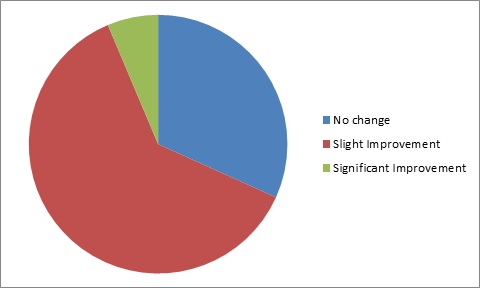
Fig 2: Effects in Pigmentation
Source: Created by Author
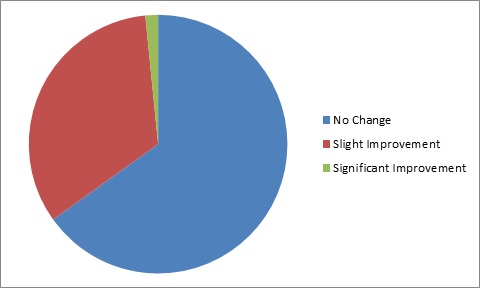
Fig 3: Effects on fine lines
Source: Created by Author
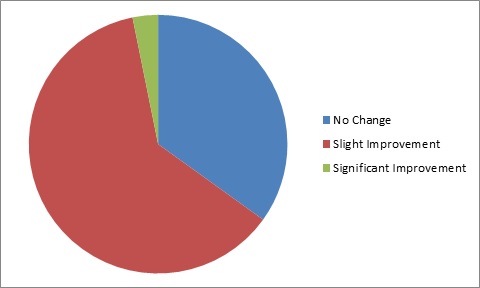
Fig 4: Effects on skin moisture content
Source: Created by Author
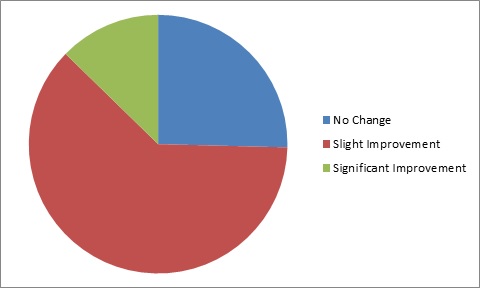
Fig 5: Effects in skin surface texture
Source: Created by Author
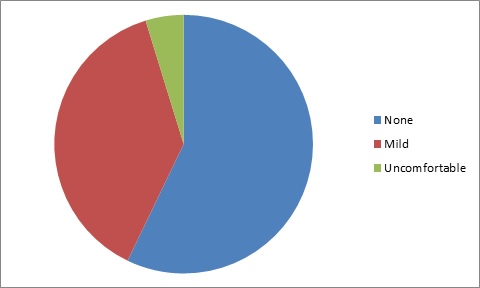
Fig 6: Side effects: stinging with initial application
Source: Created by Author
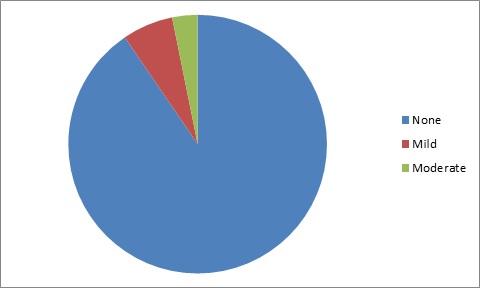
Fig 7: Side effects: erythema
Source: Created by Author
My results after application of Retinol
|
Perception Criteria |
Rating |
|
Product Texture and consistency |
Too light |
|
Effects in Pigmentation |
No change |
|
Effects on fine lines |
Slight improvement |
|
Effects on skin moisture content |
Slight Improvement |
|
Effects in skin surface texture |
No change |
|
Side effects: stinging with initial application |
Mild |
|
Side effects: erythema |
None |
Collated results of the participants after the application of Retinol
|
Perception Criteria |
Rating |
No. of Participants |
Percentage |
|
Product Texture and consistency |
Too heavy |
4 |
6.34 |
|
Comfortable |
50 |
79.36 | |
|
Too Light |
9 |
14.28 | |
|
Effects in Pigmentation |
No change |
48 |
76.19 |
|
Slight Improvement |
15 |
23.80 | |
|
Significant Improvement |
0 |
0 | |
|
Effects on fine lines |
No Change |
42 |
66.66 |
|
Slight Improvement |
18 |
28.57 | |
|
Significant Improvement |
3 |
4.76 | |
|
Effects on skin moisture content |
No Change |
39 |
61.9 |
|
Slight Improvement |
13 |
20.63 | |
|
Significant Improvement |
11 |
17.46 | |
|
Effects in skin surface texture |
No Change |
13 |
20.63 |
|
Slight Improvement |
39 |
61.9 | |
|
Significant Improvement |
11 |
17.46 | |
|
Side effects: stinging with initial application |
None |
51 |
80.92 |
|
Mild |
12 |
19.04 | |
|
Uncomfortable |
0 |
0 | |
|
Side effects: erythema |
None |
46 |
73.01 |
|
Mild |
10 |
15.87 | |
|
Moderate |
7 |
11.11 |
Graphs for the Collated results of the participants after the application of L-Ascorbic Acid
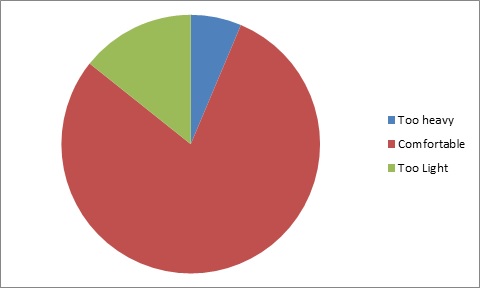
Fig 1: Product Texture and consistency
Source: Created by Author
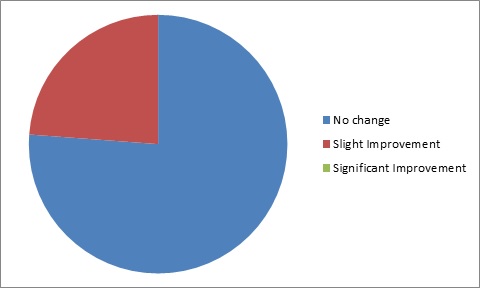
Fig 2: Effects in Pigmentation
Source: Created by Author
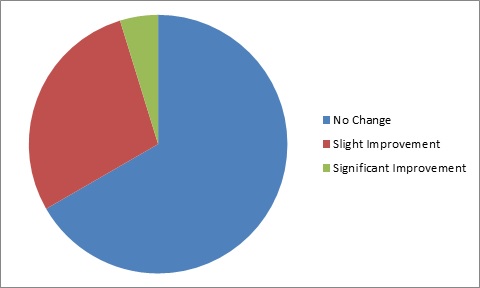
Fig 3: Effects on fine lines
Source: Created by Author
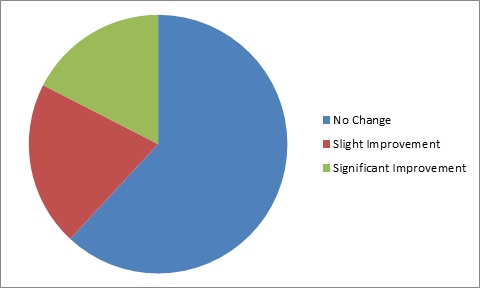
Fig 4: Effects on skin moisture content
Source: Created by Author
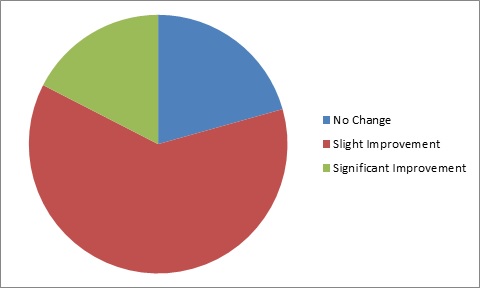
Fig 5: Effects in skin surface texture
Source: Created by Author
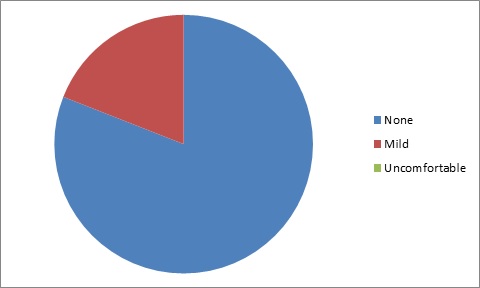
Fig 6: Side effects: stinging with initial application
Source: Created by Author
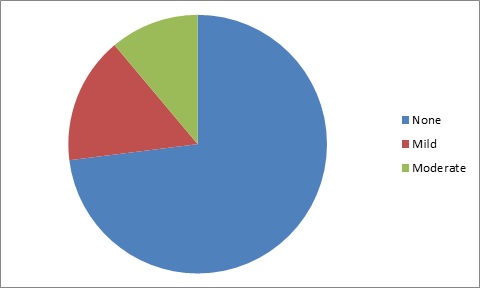
Fig 7: Side effects: erythema
Source: Created by Author
Discussion
The participants were surveyed based on seven different perception criteria of the participants and their ratings were analyzed for reaching a valid conclusion regarding the perception. When the participants were surveyed regarding their perception on the use of L-Ascorbic Acid as a topical antioxidant agent, 52.38% of the participants agreed to the fact that the texture of the product and the consistency was comfortable while almost 43% were of the view that the texture was too light. The same perception, when tested for Retinol gave the results that almost 80% of the participants agreed for the product texture being comfortable and 14% agreed to it being too light. Almost 62% of the participants voted for the perception that the product caused slight improvement in the pigmentation conditions while 6% saw a significant improvement in their skin pigmentation levels. In case of Retinol, the percentages were 23.80% and 0%. This means that L-ascorbic Acid is better in curing skin pigmentation problems than Retinol. The author of the research was one of them who observed significant effect in skin pigmentation. While 65% of the participants saw no changes in their fine lines, 33% noticed a slight improvement and only 1.58% noticed a significant improvement. 62% of the participants noticed a slight improvement in their skin moisture content when L-Ascorbic acid was used as a topical agent; the same for retinol was reportedly low, at 20.63%; this reveals the fact that L-Ascorbic acid is a better moisturizer than Retinol. Slight improvement in skin texture was reported by 62% of the participants in case of L-Ascorbic acid and almost the same results were obtained on using Retinol as well. The percentage of participants observing significant improvement in their skin texture was, however, lower in case of L-Ascorbic Acid than in Retinol. Both the products were observed to be topically safe when applied on the face; no major cross-reactions were observed except in very sensitive cases.
Reference List
Babamiri, K. and Nassab, R. (2012). Cosmeceuticals: The Evidence Behind the Retinoids. Aesthetic Surgery Journal, 30(1), pp.74-77.
Gülçin, I., 2012. Antioxidant activity of food constituents: an overview. Archives of toxicology, 86(3), pp.345-391.
Ray, P.D., Huang, B.W. and Tsuji, Y., 2012. Reactive oxygen species (ROS) homeostasis and redox regulation in cellular signaling. Cellular signalling, 24(5), pp.981-990.
Siddharth Mukherjee, G. 2018. Retinoids in the treatment of skin aging: an overview of clinical efficacy and safety. [online] PubMed Central (PMC). Available at: https://www.ncbi.nlm.nih.gov/pmc/articles/PMC2699641/ [Accessed 30 Jul. 2018].
Skinceuticals-za.com. (2018). [online] Available at: http://www.skinceuticals-za.com/resources/INT_EN/pdf/SCIENCELP_KEYSTUDY_1.pdf [Accessed 30 Jul. 2018].
Telang, P.S., 2013. Vitamin C in dermatology. Indian dermatology online journal, 4(2), p.143.
Traikovich, S. 2009. Use of Topical Ascorbic Acid and Its Effects on Photodamaged Skin Topography. Archives of Otolaryngology–Head & Neck Surgery, 125(10), p.1091.


